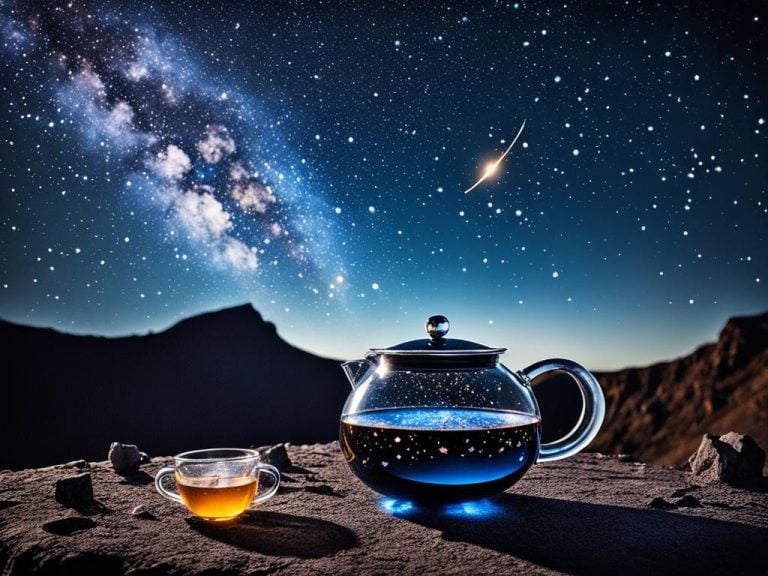Explore Crater Constellation Guide & Facts
Modified: August 26, 2024 Author: International Star Registry
Did you know that The Cup, or the Crater constellation, is a small group of stars in the Southern Hemisphere? This group was named by the Greek-Egyptian Claudius Ptolemaeus in the 2nd century CE. It doesn’t have any bright stars that stand out.
Even without bright stars, Crater is big on deep sky objects. It’s linked to Leo, Sextans, Hydra, Corvus, and Virgo. This makes it a great spot for astronomers to find cool things in the sky.
Inside Crater are amazing sights like the Crater 2 dwarf galaxy and NGC 3511 and NGC 3887 spiral galaxies. There’s also the RX J1131 quasar, over 6 billion light years away. Whether you’re new to star-gazing or a pro, Crater has wonders to show you.

Key Takeaways:
- Crater is a small constellation with no bright marker stars.
- It belongs to the Hercules family and is bordered by Leo, Sextans, Hydra, Corvus, and Virgo.
- Notable deep sky objects in Crater include the Crater 2 dwarf galaxy, NGC 3511 spiral galaxy, NGC 3887 spiral galaxy, and the RX J1131 quasar.
If you love the stars, don’t miss Crater constellation. Visit the Universe Today website for more. You’ll also find cool info at Constellation Guide.
Crater Constellation Mythology
In Greek mythology, the Crater constellation has a special tale. It’s tied to the gods and stars. Legend says the cup of god Apollo is the Crater constellation itself.
Apollo asked a raven to bring him some water in the cup. But the raven took too long. This made Apollo angry. As a punishment, he threw the cup, the raven, and a water snake into the sky. They became the constellations Corvus, Crater, and Hydra.
This story means the Crater constellation is linked to a cup. It also shows how it’s connected to other stars nearby. It adds magic to the night sky, delighting those who look up.
If you want to learn more about the Crater constellation’s story, click on Crater Constellation Mythology.
For deeper details on the Crater constellation’s legend, check out this Wikipedia page.
Astronomical Significance of Crater Constellation
The Crater constellation is not well-known for major deep sky features. But it is crucial in astronomy. It contains many stunning galaxies. These capture the eyes of astronomers and people who love looking at the stars.
The Crater constellation is important because of galaxies like NGC 3887, NGC 3511, and NGC 3981. These beautiful spiral galaxies were found by William Herschel. They make the Crater constellation special.
NGC 3887 is about 70 million light-years from us. It has amazing spiral arms and star clusters. Scientists love studying how it evolved.
NGC 3511 is around 100 million light-years away. It has a clear central bar. This unique look fascinates researchers studying galaxies.
NGC 3981 is some 65 million light-years away. It has a stunning spiral structure and a bright center. These features attract astronomers exploring spiral galaxies.
Even without flashy nebulae or star clusters, Crater’s galaxies are key. They help us learn more about the universe. Their beauty and complexity invite us to learn more about space.
Major Stars in Crater Constellation
Within the Crater constellation, many big stars light up the sky at night. Delta Crateris, or Labrum, is the brightest among them. This orange giant shines with a magnitude of 3.56, making it easy to see without a telescope.
Alpha Crateris, called Alkes, and Beta Crateris, known as Al Sharasif, are also famous in Crater. They have special names recognized by the International Astronomical Union. This makes them well-known in the science world.
Looking at these stars is amazing for anyone. A simple stargazer or a fan of astronomy, you can enjoy the wonders of the Crater constellation. It’s a chance to feel close to the universe.
Crater Constellation and Naming Stars
Today, the allure of the stars extends beyond ancient myths and legends. With International Star Registry, you have the opportunity to name a star within the Crater constellation, immortalizing your own piece of the cosmos. Whether it’s for a birthday, Christmas, or anniversary, naming a star is a unique and thoughtful gift that will be cherished for a lifetime.
To name a star in the Crater constellation, simply visit starregistry.com and follow the easy steps to select your preferred star and personalize its name. Whether you choose to honor a loved one, commemorate a special occasion, or simply indulge your fascination with the cosmos, buying a star is a meaningful gesture that transcends time and space.
The process is easy. Visit starregistry.com to start. Pick the Crater constellation and then a star. You can also make a certificate personal with the name, dedication date, and a message.
This gift really stands out. By naming a star, you give a gift that keeps shining. It’s a way to keep a special memory or person alive in the night sky. This constellation is a favorite among celebrities. Celebrities that have their very own stars named in Crater include Laura Dern, Betty Hutton, and Jillie Mack.
Crater Constellation Viewing Tips
The Crater constellation is an amazing sight in the night sky. If you wish to see this celestial wonder, follow these tips:
- Best Time: Look from November to May for the best view. The Crater constellation is clearer in the sky during these months.
- Find the Right Spot: Go to a place without city lights. This reduces light pollution and helps you see the stars clearly.
- Use Aids: A star map or a mobile app can be very handy. They will point you to the Crater constellation and its stars.
- Try Binoculars or Telescope: Binoculars or a telescope can make the view better. They let you see more details of the Crater constellation.
Stargazing requires patience. Give your eyes time to adjust to the darkness. Then, enjoy the beauty of the Crater constellation at its best.
Crater Constellation Fun Facts
Are you looking to learn about the Crater constellation? Here you’ll find some fun facts to enrich your understanding of this starry wonder.
- Crater is the 53rd biggest of the 88 constellations. It’s about 282 square degrees wide in the sky. This makes up about 0.68% of the total nighttime view.
- The brightest star in Crater is Labrum, with a brightness of 3.57. It’s roughly 185.74 light-years distant from us.
- In its boundary, Crater holds 10 stars known to have exoplanets. This makes it extra special in the science of space.
- In the Southern Hemisphere, people have the best view of Crater. It can be seen between +65° and -90° latitudes. So, get comfy and look up!
- Crater is next to other constellations like Leo, Hydra, and Virgo. These neighbors make the night sky even more beautiful.
- The best time to observe Crater is from February to June at night. April is perfect as the constellation is highest then.
- A meteor shower in Crater called the Eta Craterids happens from January 11 to 22. The best nights to see it are January 16 and 17.
- Want to know about Crater’s mythology? Dive into the ancient stories and meaning behind these patterns of stars.
- Crater includes beautiful galaxies like NGC 3887 and NGC 3981. The latter has eye-catching spiral arms thanks to gravity’s pull.
- Its shape is formed by nine distinct stars. This makes Crater unique and easy to spot in the dark sky.
These facts highlight the beauty and depth of the Crater constellation. They’re perfect whether you’re starting to explore the stars or already love stargazing.
For more on the Crater constellation, visit Go Astronomy, The Planets, or Universe Guide.

Crater Constellation and Other Constellations
Crater belongs to the Hercules family of constellations. This family includes amazing celestial formations. They are famous for cool myths, great stars, and their part in the sky. Besides Crater, there’s Aquila, Corona Australis, Lyra, and more.
By learning about Crater’s neighbors, you make stargazing better. Corvus, Hydra, Leo, and others are nearby. They make a beautiful group in the night sky. Each has its own stories and awesome stars to find.
Finding your way around these constellations is fun. It shows how big and beautiful our universe is. The connections between them are really cool.
Crater Constellation Family:
- Aquila
- Corona Australis
- Lyra
- Ophiuchus
- Sagitta
Crater Constellation Neighboring Constellations:
- Corvus
- Hydra
- Leo
- Sextans
- Virgo
Discovering these constellations shares a whole world of new stars. They all have special tales and symbols. So, explore beyond Crater. Take an amazing trip through the whole family and see the sky like never before.
Crater Constellation Galaxies
In the vast Crater constellation, you can find many stunning galaxies. Notable ones include NGC 3887, NGC 3511, NGC 3513, and NGC 3981. These are spiral galaxies with their own size, distance, and lovely features.
NGC 3887 and NGC 3981, both beautiful spiral galaxies, were found by William Herschel. They give a breathtaking view of the universe to astronomers and fans of the night sky alike.
Want to know more about the Crater constellation and its secrets? Check out these links:
Start exploring the Crater constellation. Find out the amazing stories behind these galaxies.
Crater Constellation: Crater 2 Dwarf Galaxy
Crater 2 is an amazing part of the dwarf galaxy cluster around our Milky Way. As the fourth largest dwarf galaxy, it circles our galaxy. But, we only noticed it in 2016 because it doesn’t shine brightly.
They call it the “feeble giant.” It sits about 380,000 light-years from us. As a part of the Crater Constellation, it’s a thrill for people who love the stars.

Its find helps us learn more about our vast universe. By looking at dwarf galaxies like Crater 2, scientists see into our universe’s past. They learn about the way dark matter moves and how everything started.
Studying Crater 2 gives us a close look at a dwarf galaxy. Learning about its makeup and habits tells us more about the space around us. It’s a key piece in understanding our universe.
Conclusion
Now, you know a lot about the Crater Constellation Guide. You have learned about its stories and why it is important. Crater is full of wonders for us to enjoy.
Even though it doesn’t have many deep sky objects, Crater is still special. Also, galaxies found by William Herschel are in this area. The brightest star here, Delta Crateris, lights up the night beautifully.
Naming a star in Crater is a great gift idea. It makes for a unique and memorable present. International Star Registry lets you do this. Be sure to visit their website at www.starregistry.com.
The best time to check out Crater is from November to May. So, get your telescope ready. You will see why Crater is so important in our night sky.
FAQ
What is the Crater constellation?
The Crater constellation is a Greek constellation noted by Ptolemy. He recorded it in the 2nd century. This cluster is in the south sky and symbolizes the cup of Apollo in myths.
What is the mythological significance of the Crater constellation?
In Greek myths, the Crater constellation is the cup of Apollo. The story goes Apollo threw a cup, a raven, and a snake into the stars when he was mad.
Are there any notable deep sky objects in the Crater constellation?
Not many deep sky wonders are known in the Crater’s area. Still, it does host spiral galaxies like NGC 3887, NGC 3511, and NGC 3981.
What are the major stars in the Crater constellation?
Delta Crateris, also called Labrum, shines the brightest in Crater. Alkes (Alpha Crateris) and Al Sharasif (Beta Crateris) are other noticeable stars.
How can I name a star in the Crater constellation?
To name a star in Crater or any constellation, try International Star Registry. More details are at their website, starregistry.com.
When is the best time to view the Crater constellation?
Seeing Crater is great from November to May. Try to watch from a dark spot for the best sight.
What are some fun facts about the Crater constellation?
The Crater constellation ranks 53rd in size among 88. It contains three planets and is linked to the Eta Craterids shower.
How does the Crater constellation relate to other constellations?
Crater is part of the Hercules family, surrounded by Corvus, Hydra, Leo, Sextans, and Virgo.
Are there any galaxies in the Crater constellation?
Yes, Crater has galaxies like NGC 3887, NGC 3511, NGC 3513, and NGC 3981.
What is the Crater 2 dwarf galaxy?
Crater 2 is a dwarf galaxy near the Milky Way. It’s the fourth largest, 380,000 light-years from us.
Source Links
- Stars, Myth, Facts, Location – Constellation Guide – https://www.constellation-guide.com/constellation-list/crater-constellation/
- Crater Constellation Fun Facts for Kids – https://www.ouruniverseforkids.com/crater-the-cup/
